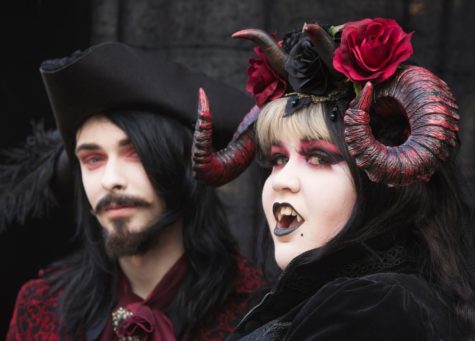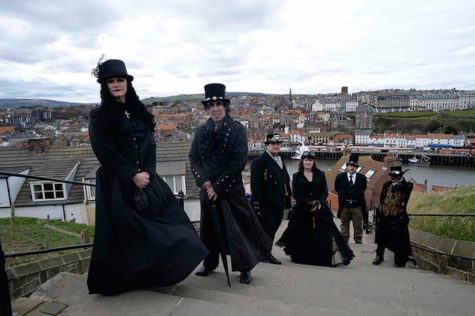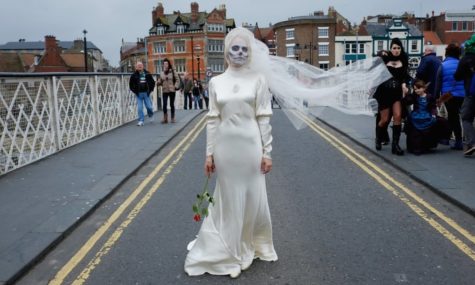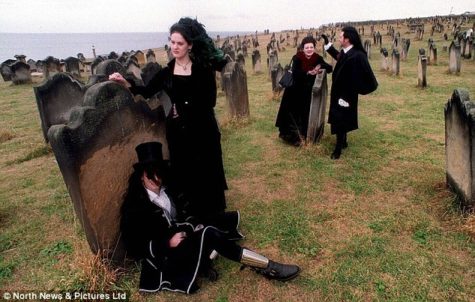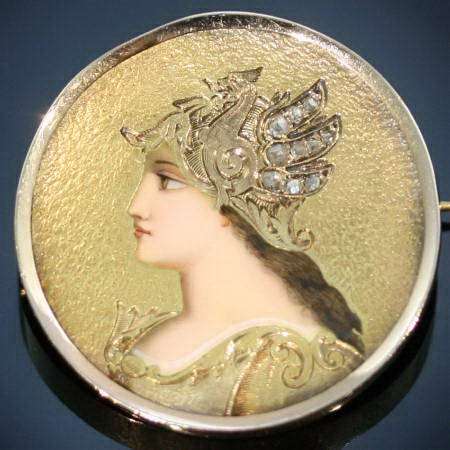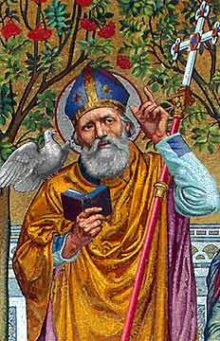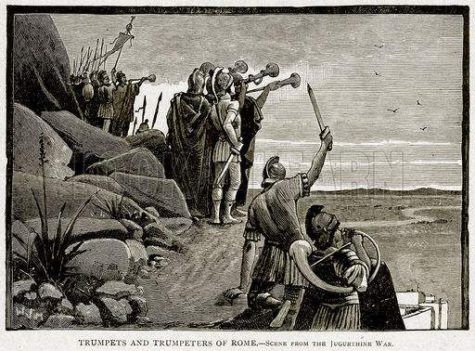Music
Whitby Goth Weekend is an alternative music festival held in Whitby. The event consists of two nights of live bands at the town’s largest venue, The Spa Pavilion, and three days of alternative trade stalls at the Spa Pavilion, Whitby Leisure Centre, and Whitby Brunswick Centre.
Dates for 2019 are as follows:
- 12-14 April
- 25-27 October
The festival was held yearly until 1997, when it became twice-yearly in April and October. It has grown into one of the world’s most popular goth music events attracting around 1,500+ attendees from across the UK and beyond. The term “Whitby Goth Weekend” is sometimes used as a generic term to describe events during the week in Whitby as a whole, although the name of the event and its associated logo are registered trademarks of Jo Hampshire of Top Mum Promotions.
The main event is held in the town’s largest venue Whitby Spa Pavilion (known as the Spa) and the Bizarre Bazaar ‘Goth Market’ is also held there and at Whitby Leisure Centre and the Brunswick Centre. Access to the Spa in the evening requires a ticket and live bands play on both Friday and Saturday from 08:00 until about midnight.
The “weekend” starts during the day on Friday and fringe events are held on Thursday, Sunday and Monday including club nights, markets, and a charity football match between visiting goth team Real Gothic, and local team Stokoemotiv Whitby.
During the October/November event there is an independent custom car show, ‘Whitby Kustom’ in the grounds of West Cliff School. There are also several “meet ups” aimed at goths with a particular interest, e.g. Lolita Goth.
Newbies who have not attended the event before are referred to as “Whitby Virgins”. To help introduce them to the event, there was a WGW Virgins Meet Up on the Friday morning at the Spa until about 2014.
In the mid-2000s the October weekend on or near Halloween began to attract large numbers of non-goths in Halloween, horror, historical, fantasy and sci-fi costume, which has led to an increase in photographers and visitors. The weekend now attracts other alternative subcultures, including Victorian vampires, rockers, punks and members of the steampunk subgenre.
Some regulars consider it no longer a purely “Goth” weekend, and it was acknowledged by Hampshire in the 2014 Whitby Goth Weekend Guide that in order to survive the event would have to diversify into other areas that have influenced Goth.
Concerns have grown about disrespect being shown to the graves in St. Mary’s Churchyard by photographers using them for photographic purposes which has resulted in a petition to have the area closed during the event, an action that Whitby Goth Weekend fully supports. The Bram Stoker Film Festival, which also took place in the town, rehashed a proposal to build a film set graveyard which photographers would be charged to use.
Sources:
According to many pagan calendars, May 8th is listed as “The Festival of Mens , the Roman goddess of mind and consciousness.” I did not, however, find any information on Mens or on a festival of Mens – what I did find was this small excerpt at Wikipedia:
By a process of folk etymology, the Romans could have confused the phones of her foreign name with those of the root men- in Latin words such as mens meaning “mind”, perhaps because one of her aspects as goddess pertained to the intellectual. The word mens is built from the Proto-Indo-European root *men- ‘mind’ (linked with memory as in Greek Mnemosyne; memory, remembrance, recollection, Manush in Sanskrit meaning mind ).
Because of this, I can only assume that the Festival of Mens is actually a Festival of Minerva, Goddess of wisdom and learning, meditation, inventiveness, accomplishments, the arts, spinning and weaving, and commerce. Minerva was identified with Pallas Athene, bestower of victory, when Pompey the Great built her temple with the proceeds from his eastern campaigns.
The Romans celebrated her festival from March 19 to March 23 during the day which is called, in the neuter plural, Quinquatria, the fifth after the Ides of March, the nineteenth, an artisans’ holiday. A lesser version, the Minusculae Quinquatria, was held on the Ides of June, June 13, by the flute-players, who were particularly useful to religion.
Source: Wikipedia
March 21 is the third day of the Quinquatria. A five day Roman festival to honor Minerva which coincides with the five day Ancient Greek festival to honor Athena – her Greek counterpart. Here is a ritual designed for group participation. It can, however, be modified for the solitary practitioner.
- Color: Blue
- Element: Air
- Altar: Upon a blue cloth lay many musical instruments, blue candles, a clear glass bowl of water, and a fan made from a bird’s wing.
- Offerings: Song and music.
- Daily Meal: Light vegetarian meal.
Quinquatria Invocation II
(to be sung)
Hail Athena, true and bright,
Sharp your blade and keen your sight,
Goddess of a Thousand Works,
Giver of the soul in flight.
Guide our touch as we reach out,
Weaver, crafter, artisan,
Guide our urge to build and make,
Guide the power of our hands.
Mentor, teacher, patient tutor,
Maker of heroes through the years
In the epic glance of history,
Giving sight to blinded seers,
Giving purpose to the wanderer,
Giving courage to the weak,
We beseech you, armored Lady,
By the Word of Power you speak,
Like the wind that blows so cold
And bright and clear through minds of grey,
Stand beside us when we falter,
Sweep our weakness clean away.
(The rest of the day should be spent in song, whatsoever has been chosen by the community as the absolute best that they can do, as an offering. Songs can be solo offerings, or as a group. Those who wish to give private offerings can play instrumental music after the main group has left.)
Found in: Pagan Book of Hours
- Colors: red, green, white
- Plants: Daffodils, leeks
- Activities: Send flowers, attend concerts, host a dinner party
Saint David’s Day is the feast day of Saint David, the patron saint of Wales, and falls on 1 March each year. The date of 1 March was chosen in remembrance of the death of Saint David on that day in 589, and has been celebrated by followers since then. The date was declared a national day of celebration within Wales in the 18th century.
The 17th century diarist Samuel Pepys noted how Welsh celebrations in London for St David’s day would spark wider counter-celebrations among their English neighbors: life-sized effigies of Welshmen were symbolically lynched, and by the 18th century the custom had arisen of confectioners producing ‘Taffies’ – gingerbread figures baked in the shape of a Welshman riding a goat – on St David’s Day.
In 2003 in the United States, St. David’s Day was recognized officially as the national day of the Welsh, and on 1 March the Empire State Building was floodlit in the national colors, red, green and white. It is invariably celebrated by Welsh societies throughout the world with dinners, parties, recitals and concerts.
To celebrate this day, people wear a symbol of either a leek, or daffodil. The leek arises from an occasion when a troop of Welsh were able to distinguish each other from a troop of English enemy dressed in similar fashion by wearing leeks. An alternative emblem developed in recent years is the daffodil.
Source: Unknown
 In Greek tradition, the Goddess Mnemosyne gave birth to the Muses today (June 14) – the nine creative spirit children that give our lives so much beauty, song, stories, tradition, humor, dance, and sacred music. For a magickal celebration here is something from A Daily Guide to the Magic and Inspiration of the Goddess.
In Greek tradition, the Goddess Mnemosyne gave birth to the Muses today (June 14) – the nine creative spirit children that give our lives so much beauty, song, stories, tradition, humor, dance, and sacred music. For a magickal celebration here is something from A Daily Guide to the Magic and Inspiration of the Goddess.
- Themes: Creativity; Knowledge; History; Art
- Symbols: Fountains; Springs; the Number Nine
- Presiding Goddess: Mnemosyne
About Mnemosyne:
Greeks sometimes worshiped Mnemosyne in the form of a spring, alluding to her profuse, flowing energy. Mnemosyne means “memory.” Remembrance is this goddess’s gift to us, memories of all the wonderful moments of our lives.
To do today:
Absolutely anything thoughtful, creative, or inspiring will grab Mnemosyne’s attention and encourage her participation in your day. Try donning a unique combination of clothing that really motivates you to do your best, or something that provokes fond memories from the past. Wear an aroma that arouses your inventive nature or cognitive abilities (jasmine and rosemary are two good choices, respectively).
If there are special arts that you’ve learned from family or friends, celebrate them today. Hum that little ditty from your childhood, dust off that neglected craft item, try those recipes, listen to old songs, and let Mnemosyne fill your hours with the encouragement that comes from fond “musings.”
The month of March was the traditional start of the campaign season, and the Tubilustrium was a ceremony to make the army fit for war. It was held on March 23, the last day of the Greater Quinquatrus (the festival of Mars and Minerva), and it occurred again on May 23.
The sacred trumpets (tubae) were originally war trumpets, but later they were used for ceremonial occasions. It is not clear if the army was involved, or if it was merely a ceremony to purify the trumpets used in summoning the assembly on the following day.
The ceremony was held in Rome in a building called the Hall of the Shoemakers (atrium sutorium) and involved the sacrifice of a ewe lamb. Romans who did not attend the ceremony would be reminded of the occasion by seeing the Salii dancing through the streets of the city.
Found at: Wikipedia
